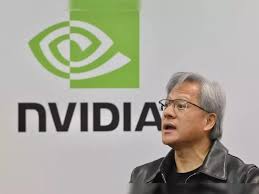The Silent Rise of Nvidia: From Graphics Cards to AI Superpower
In a tech world dominated by flashy headlines and billion-dollar acquisitions, one company has risen quietly—but powerfully—to sit at the very heart of the AI revolution: Nvidia. While once known primarily among gamers for its graphics cards, Nvidia has become one of the most valuable and influential tech giants of our time. But how did this happen? How did a company that started with graphics for gaming grow into the backbone of artificial intelligence, self-driving cars, supercomputing, and even the metaverse? Let’s break down the silent, strategic rise of Nvidia—from pixels to power.
5/15/20253 min read


From Humble Beginnings: The Birth of Nvidia
Nvidia was founded in 1993 by Jensen Huang, Chris Malachowsky, and Curtis Priem with a focus on computer graphics acceleration. At a time when gaming was becoming more immersive and 3D graphics were emerging, Nvidia bet big on the growing demand for high-performance visual computing.
Their breakthrough came with the release of the GeForce 256 in 1999, marketed as the world's first GPU (Graphics Processing Unit). This single piece of hardware transformed gaming by delivering real-time 3D graphics—making Nvidia a household name among PC gamers.
For a while, Nvidia’s dominance remained mostly within the gaming community. But behind the scenes, the company was laying the foundation for something much bigger.
Parallel Computing: The Silent Pivot That Changed Everything
While everyone focused on prettier games and higher frame rates, Nvidia engineers had a vision: what if GPUs could be used not just for graphics, but for computation?
That led to the birth of CUDA (Compute Unified Device Architecture) in 2006—a software platform that allowed developers to use Nvidia GPUs for general-purpose parallel computing. It quietly unlocked the true potential of GPUs beyond gaming.
Researchers and scientists embraced this new model, finding that GPUs could accelerate complex calculations far more efficiently than CPUs. This move was pivotal—without making a splash in mainstream media, Nvidia had just stepped into the future of computing.
AI’s Rise—And Nvidia’s Moment of Destiny
As machine learning and artificial intelligence took off in the 2010s, one thing became clear: training deep learning models required enormous processing power.
Enter Nvidia. Its GPUs—built for parallel processing—were perfect for the task. In fact, the most powerful AI models today, including those used in natural language processing, image recognition, and autonomous driving, all rely on Nvidia’s hardware.
Companies like OpenAI, Google, Meta, and Tesla use Nvidia-powered systems to train large-scale models. Without Nvidia GPUs, today’s AI boom might have looked very different.
Beyond Chips: Building an AI Ecosystem
Nvidia didn’t stop at hardware. It invested heavily in building an entire AI ecosystem. This includes:
Nvidia DGX Systems: Supercomputers built specifically for AI training.
Jetson Platform: AI on the edge—for robotics, drones, and IoT.
Omniverse: A 3D simulation and collaboration platform that enables digital twin environments and metaverse creation.
Nvidia AI Enterprise: A full-stack suite of tools for AI development across industries.
By creating both hardware and software infrastructure, Nvidia made itself indispensable to AI innovators.
Strategic Acquisitions That Shaped the Future
Nvidia has also made smart, strategic acquisitions to expand its capabilities:
Mellanox Technologies (2019): Strengthened its networking and data center capabilities.
Arm Holdings (attempted acquisition): Though blocked by regulators, the move revealed Nvidia’s ambition to dominate mobile and low-power computing.
Run:ai and others: Focused on optimizing AI workloads and orchestration.
Each acquisition wasn’t just about growth—it was about positioning Nvidia at the center of computing's next evolution.
Nvidia’s Market Explosion
While other tech giants made headlines with consumer gadgets, Nvidia's rise was quiet—but dramatic. By 2023, Nvidia’s stock had soared, pushing its market cap past $1 trillion, briefly making it one of the most valuable companies on Earth.
What’s stunning is how few outside of tech and finance circles saw it coming. Nvidia didn't need a flashy social platform or hardware launch event—it let its chips do the talking.
Challenges on the Horizon
Of course, no tech empire grows without resistance. Nvidia faces:
Growing competition from AMD, Intel, and custom AI chipmakers like Google (TPUs) and startups like Cerebras.
Supply chain vulnerabilities in a geopolitically tense chip market.
Regulatory pressure, especially around monopolistic behavior and acquisitions.
The risk of over-dependence on AI, which is still an evolving field.
But so far, Nvidia’s leadership, innovation, and clear long-term strategy have kept it ahead of the curve.
What Nvidia’s Rise Means for the Future of Tech
Nvidia is no longer “just” a chipmaker—it’s a platform company. Its technology powers:
AI research labs
Autonomous vehicles
High-performance computing
Cloud gaming
Metaverse simulations
Digital healthcare and more
In essence, Nvidia has become the infrastructure layer of modern digital transformation.
For startups, it offers the tools and horsepower to innovate. For enterprises, it enables scalability. For developers, it provides a gateway to the next computing era.
Conclusion: The Power Behind the Curtain
While companies like Apple, Microsoft, and Google dominate headlines, Nvidia has become the silent superpower behind the digital revolution.
From revolutionizing gaming graphics to enabling the AI that’s reshaping our world, Nvidia’s journey is a masterclass in strategic evolution and quiet dominance.
And as AI, robotics, and immersive virtual experiences continue to grow, the world will be running on Nvidia more than most people realize.
Explore how Nvidia quietly rose from a gaming GPU brand to a global AI superpower, powering breakthroughs in artificial intelligence, autonomous vehicles, and the future of computing.
#Nvidia
#NvidiaAI
#ArtificialIntelligence
#MachineLearning
#DeepLearning
#AITechnology
#AIEvolution
#AIRevolution
#FutureOfTech
#AIComputing
#GenerativeAI
#TheTechInnovative
If you have any suggestion contact us here